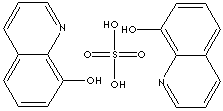| CAS
NO. |
134-31-6 |

|
| EINECS
NO. |
205-137-1 |
| FORMULA |
(C9H7NO)2.H2SO4 |
| MOL
WT. |
388.40 |
|
H.S.
CODE
|
|
|
TOXICITY
|
|
| SYNONYMS |
8-Quinolinol
hemisulfate; 8-Quinolinol sulfate;
|
| 8-Quinolinol,
sulfate (2:1) (salt); chinosol; cryptonol; oxyquinoline
sulfate; 8-quinolinol, hydrogen sulfate(2:1); 8-hydroxyquinoline
sulfuric acid salt; quinosol; Oxine sulfate; Hydroxyquinoline
sulfate; Quinolinol sulfate; |
|
CLASSIFICATION
|
|
|
PHYSICAL
AND CHEMICAL PROPERTIES
|
| PHYSICAL
STATE |
pale
yellow crystalline powder |
| MELTING
POINT |
175
- 178 C |
| BOILING
POINT |
|
| SPECIFIC
GRAVITY |
|
| SOLUBILITY
IN WATER |
soluble |
| pH |
|
| VAPOR
DENSITY |
|
|
AUTOIGNITION
|
|
|
NFPA
RATINGS
|
|
|
REFRACTIVE
INDEX
|
|
| FLASH
POINT |
Not
expected to be a fire hazard |
| STABILITY |
Stable
under ordinary conditions |
|
APPLICATIONS
|
| Quinoline,
hygroscopic, yellowish oily liquid, is an aromatic nitrogen
compound characterized by a double-ring structure contains
a benzene and a pyridine. (Pyridine is a ring structure compound
of five carbon atoms with a nitrogen atom). These
two rings are fused at two adjacent carbon atoms. Quinoline
itself is the simplest member of the quinoline. It can be prepared
by the distillation of coal tar or by synthesis from
aniline. It is soluble in water as well as in alcohol,
ether, and carbon disulfide. Isoquinoline differs from
quinoline in nitrogen position. Quinoline family compounds
are widely used as a
parent compound to make drugs (especially anti-malarial medicines), fungicides,
biocides, alkaloids,
dyes, rubber chemicals and flavoring agents. They have antiseptic, antipyretic, and antiperiodic properties. They are also used as catalyst, corrosion inhibitor, preservative, and as solvent for resins
and terpenes. They are used in transition-metal complex catalyst chemistry for uniform
polymerization and luminescence chemistry. Oxyquinoline, Hydroxyquinoline at 8- position, is used as a bacteriostatic and
fungistatic agent. It is used in preparing antiseptics, deodorants,
antiperspirants, and fungicides. The sulfate salt of 8-hydroxyquinoline is used as a
complexing agent for pharmaceuticals.
|
| SALES
SPECIFICATION |
|
APPEARANCE
|
pale
yellow crystalline powder |
|
PURITY
|
98.5%
min
|
| MELTING
POINT |
175
- 178 C |
| TRANSPORTATION |
| PACKING |
25kgs
in fiber drum |
| HAZARD
CLASS |
Not
regulated |
| UN
NO. |
|
| OTHER
INFORMATION |
| Hazard Symbols: XN, Risk Phrases: 22, Safety Phrases:
36 |
| GENERAL
DESCRIPTION OF DISINFECTANT
|
Disinfectant
is an agent applied to inanimate objects
to destroy, neutralize, or inhibit the
growth of disease-carrying microorganisms,
(whereas antiseptics are applied primarily
to living things). Heat and radiation
are also disinfectants. Common ingredients
of chemical disinfectant are:
- Mercuric
Chlorides
- Formaldehyde
- 8-Hydroxyquinoline
- Copper
Hydroxide
- Cresol
- Alcohols
(Ethyl Alcohol; Isopropyl Alcohol)
- Iodines
/ Iodophors
- Chlorine
releasing compounds
- Gluteraldehyde
- Phenolics
- Quaternary
Ammonium Compounds
|
PRICE INFORMATION
|
 |
